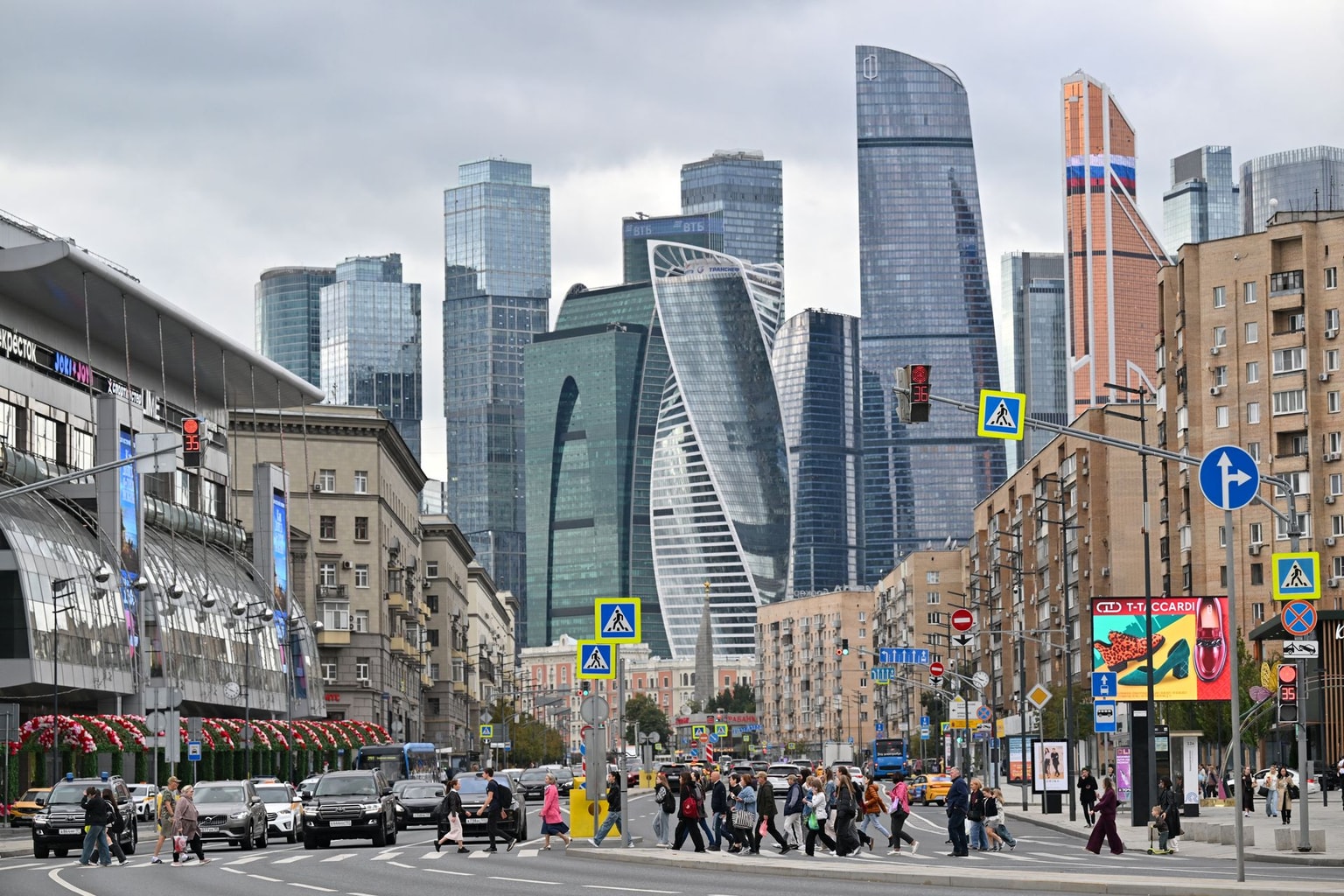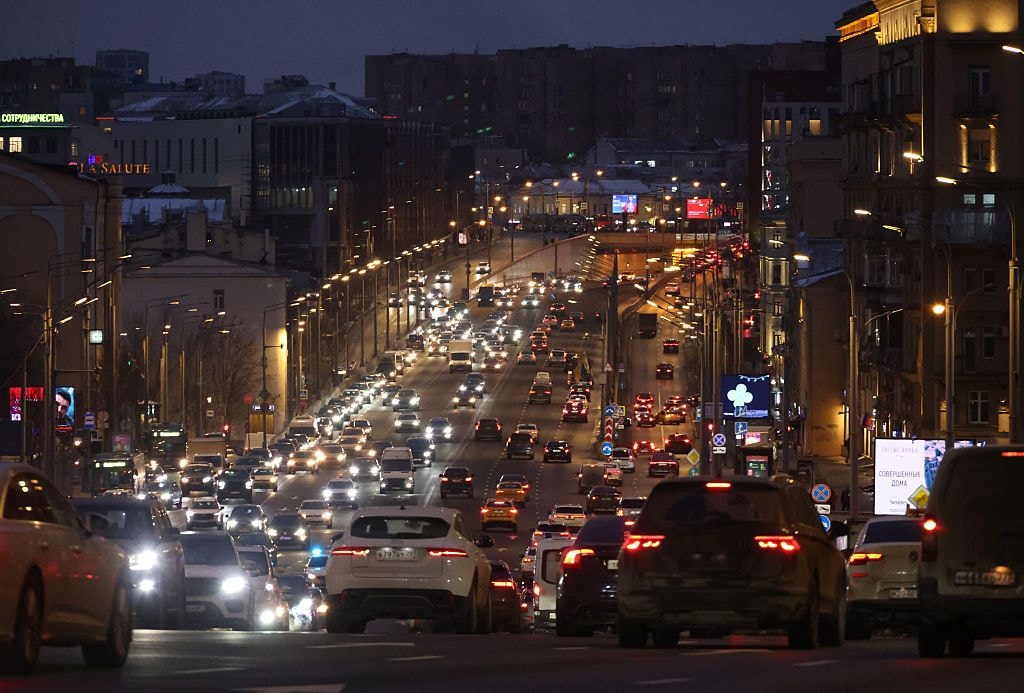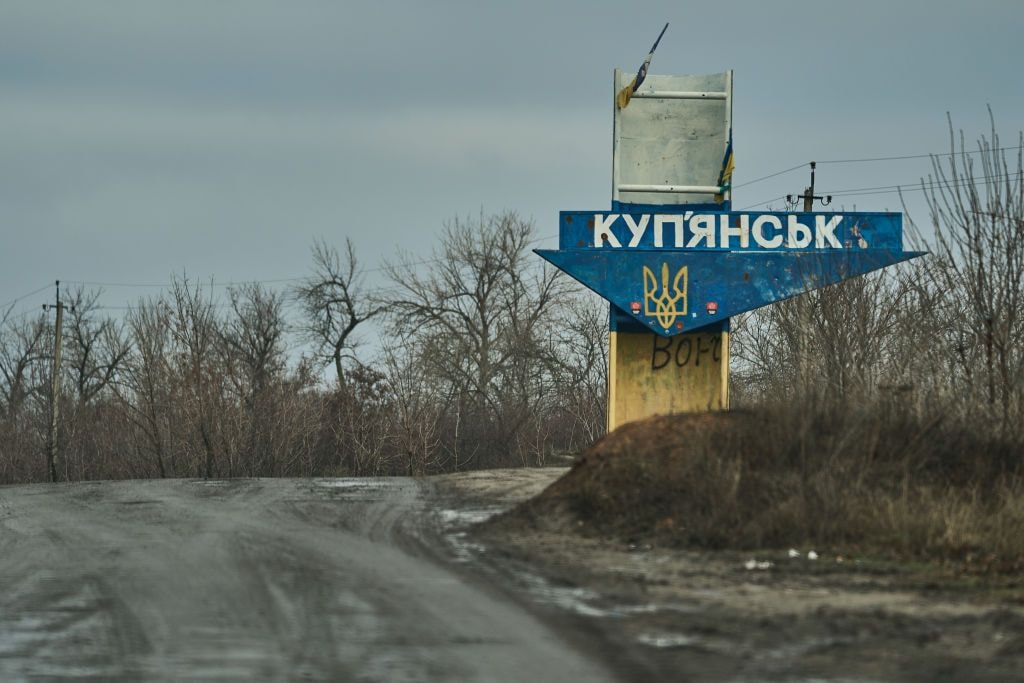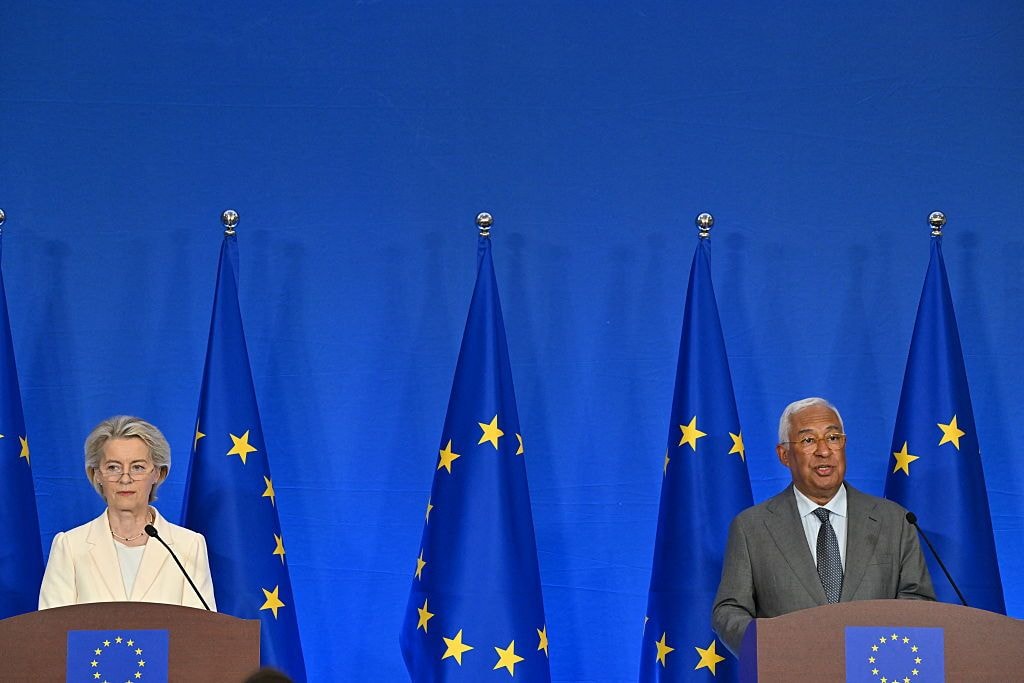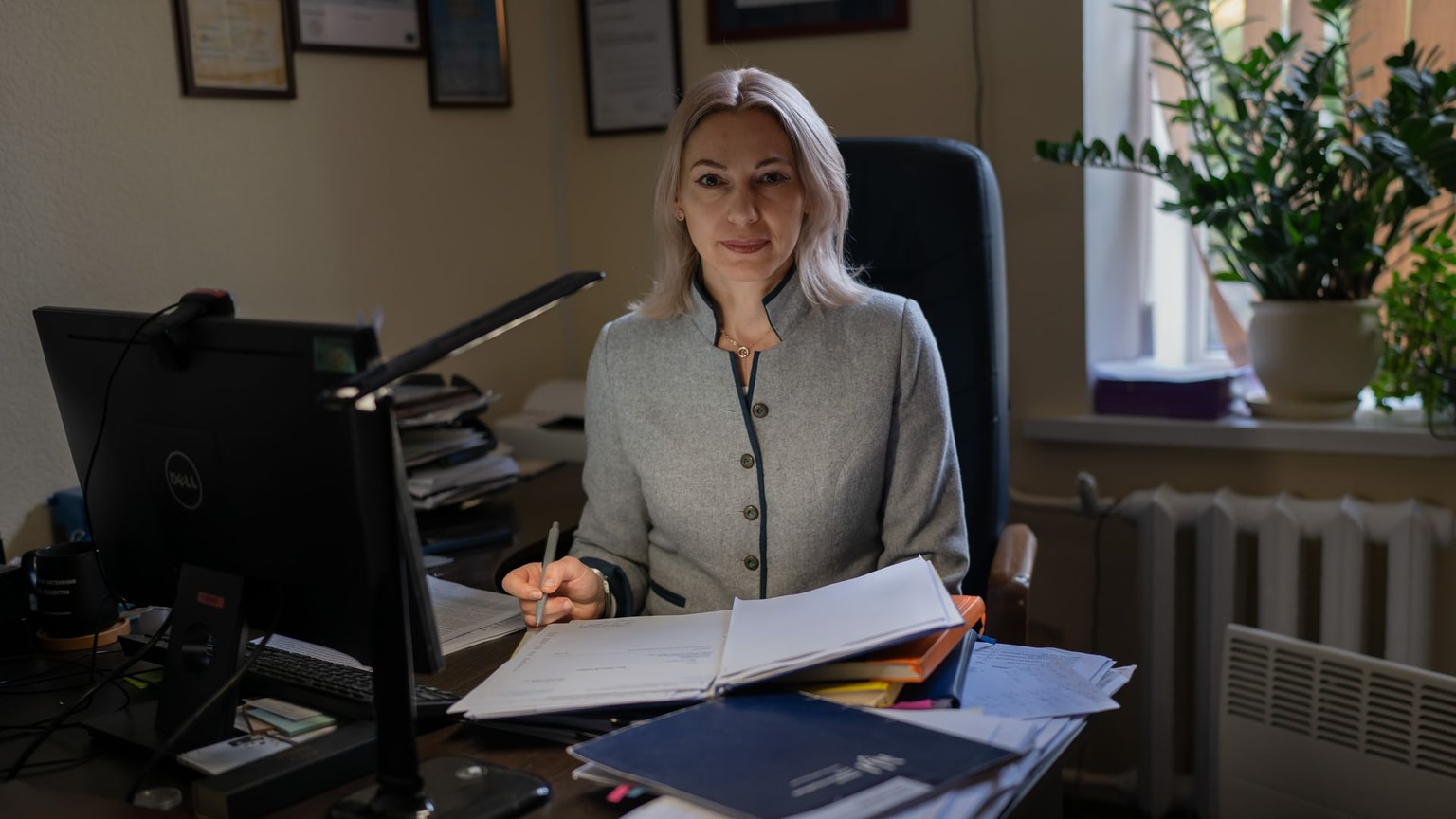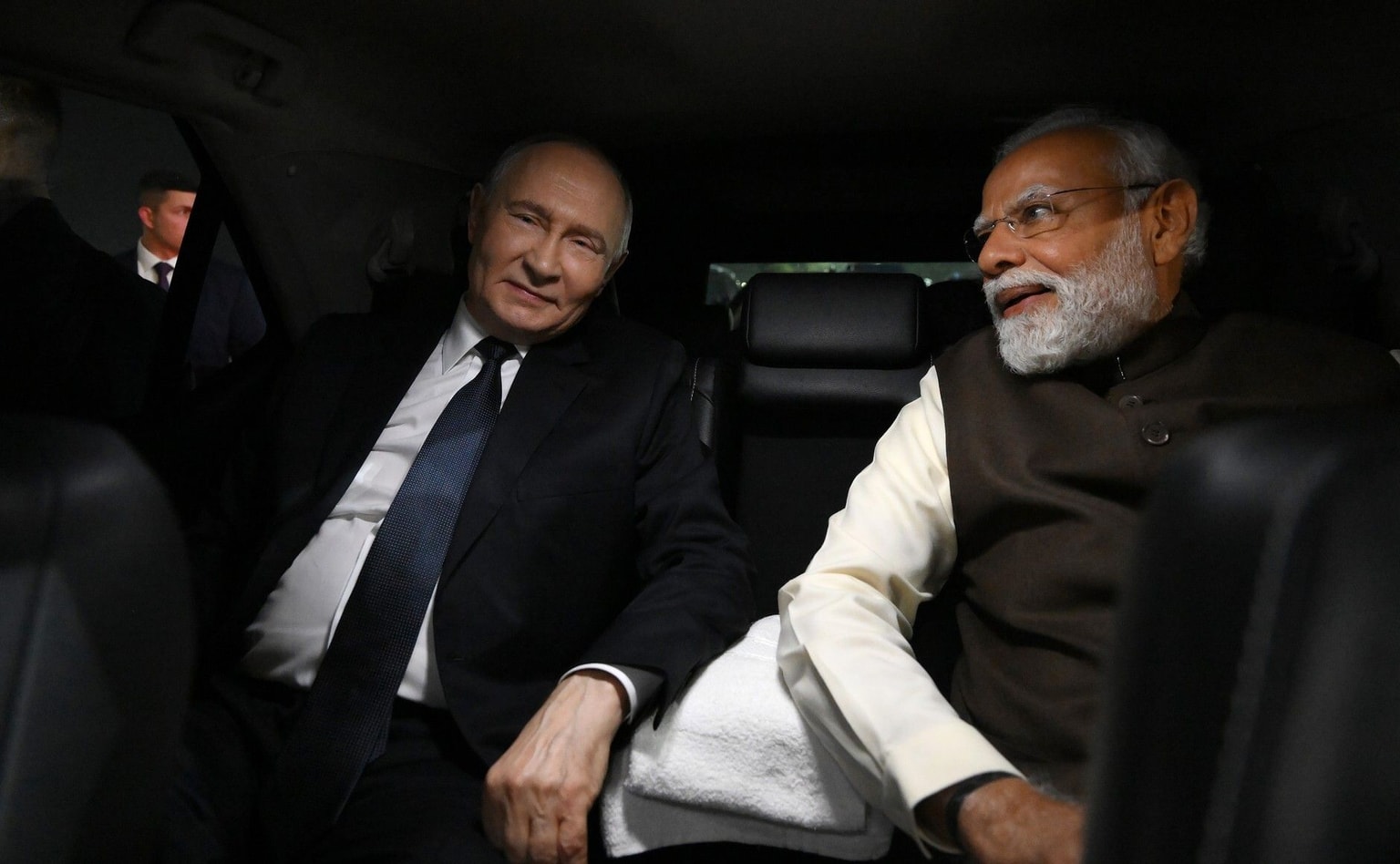
How will the Russia-Ukraine war end? The good, the bad, and the ugly scenarios
A deep dive into the perilous negotiating ahead for Ukraine and the scenarios that could come out of it.
Ukrainian soldiers fire D-30 artillery near Toretsk, Donetsk Oblast, on Dec. 8, 2024. (Diego Herrera Carcedo/Anadolu via Getty Images)
Editor's note: This article is based on a publicly available research report on scenarios for the end of Russia’s war on Ukraine by KI Insights, the Kyiv Independent’s research unit. Read Francis Farrell's full report here.
After nearly three years of heavy battles and mass strikes, Russia’s full-scale war against Ukraine is showing signs of accelerating toward what could be its final act, for now at least.
Over the summer and autumn of 2024, the battlefield situation markedly turned for the worse for Kyiv, as Russia has begun capturing territory at a greater pace since the first months of the full-scale invasion.
The resounding victory in the U.S. presidential elections of former President Donald Trump, who has been openly scathing of U.S. military and financial aid to Ukraine and the inner circle of whom have spread anti-Ukrainian narratives on the war, has put the future of Ukraine’s ability to hold Russia back in grave doubt.
Meanwhile though, the incoming U.S. president has nonetheless claimed repeatedly to be able to end the war quickly upon his inauguration in January.
Given the slow-burn failure of the West’s current policy to support Ukraine enough to simply survive rather than win in the face of Russia’s war of attrition, many Ukrainians, from officials to soldiers and civilians, have expressed quiet hope that Trump could get tough with Russian President Vladimir Putin in an effort to stop Russia’s advance.
But Washington is not a direct belligerent in the full-scale war, which began with Russia's attempt to decapitate independent Ukraine through an attack on Kyiv, and which has since continued with all evidence that Putin’s maximalist goals remain in place.
Stirred already by the full-scale invasion, European nations have meanwhile realized the urgent need to scale up defense production in light of an incoming president Trump, who has openly questioned if he would honor Article 5 of the NATO Treaty.
But behind loud public statements from European leaders on taking more responsibility for the continent’s own security, the question of whether these plans also include brave steps to secure Ukraine’s future is usually left unanswered.
With just over a month until Trump’s inauguration, both Kyiv and Moscow are jostling to best improve their negotiating positions ahead of what is likely to be a dynamic winter, both on the battlefield and in the geopolitical arena.
Realistic scenarios for Ukraine: from hopeful to hellish
Excluding developments that are grounded more in wishful thinking than in reality, such as Ukraine’s overstretched military conducting major counteroffensives, or Russia’s economy suffering a sudden collapse, realistic endpoints to Russia's war against Ukraine can begin to take shape.
Through this prism, possible war termination scenarios quickly split into four broad options.
SCENARIO 1:
Peace with frozen lines and a secure Ukraine
The most positive scenario for ending the war for Kyiv: achieving a peace built upon rock-solid safeguards against a repeat invasion, even if without all of its territory, for now. In his Victory Plan presented to world leaders in October, Zelensky spoke of an invitation to NATO and the stationing of long-range missiles in Ukraine as a deterrence. Almost certainly, European nations will have to lead the way, likely by bringing non-combat boots on the ground on their own initiative and generally integrating free Ukraine into Europe's security architecture. The main question is why Russia would agree to stop on the battlefield on such terms.

SCENARIO 2:
Ceasefire with frozen lines, no secure Ukraine
Scenario 2 encompasses an end to active hostilities with no serious provisions that provide a hard deterrent for a repeat Russian invasion of Ukraine. The result of a distracted, divided West simply wanting the fighting to stop without losing too much face, and a Kremlin leadership that could be ready to oblige. Variants of this peace plan could bear similarities to the Minsk Agreements, with non-armed international observers and rules on heavy weapons, and could also include the abandoning of Ukraine's NATO aspirations to save face for the Kremlin short-term. Conversely, with positions hardened and both Zelensky and Putin worried that signing any peace deal would project weakness, Scenario 2 could also go no further than a shaky ceasefire. Ultimately, a repeat invasion will be expected; Kyiv and Europe will have to race to prepare.

SCENARIO 3:
Desperate, compromised peace
Ukraine finds itself in a quickly deteriorating position on the battlefield, with not enough hard support from the U.S. or Europe to even secure a freezing of the front lines. In a desperate effort to stave off total defeat, Kyiv sues for peace. Holding all the power, Moscow can set almost any and all terms that it sees fit as the price for stopping its advance on the battlefield. These could include limits on military size and weaponry, giving the Russian language co-official status, or other constitutional changes designed to permanently undermine Ukrainian sovereignty and democracy. If Moscow decides to go further, it could demand a harder capitulation in the form of recognizing and handing over the remaining Ukrainian-controlled territory in the four regions newly-annexed by Russia, including Zaporizhzhia and Kherson. Such territorial concessions are completely unthinkable for Ukraine but may loom if there is literally no other hard barrier or leverage to stop Russia from taking as much of Ukraine as it pleases.

SCENARIO 4:
No peace, Russia doesn't stop
Both the U.S. and Europe fail to come up with a convincing answer to "Why should Russia stop?" Aid is insufficient to stop Moscow on the battlefield, and the manpower crisis opens wider holes in Ukraine's defense that continue to be exploited by Russian forces. The Trump administration puts forward different peace plans to Putin, using both carrot and stick, but Moscow simply decides to keep going, feeling no hard resistance. Europe fails to muster a brave response outside the limits of a Trump-Putin-Zelensky deal. Kyiv either refuses to sue for a peace that could lead to Scenario 3 or tries to do so but is rejected by Moscow. Potential for new fronts to open along the northern border. A new wave of millions of refugees heads toward Europe. Kyiv becomes weak and unstable on the brink of military defeat. The end result of the war depends on Russia's maximal territorial goals in Ukraine.

The Russia problem
Both in the lead-up to and after the election, most media reporting has struggled to get to the core of what the task of ending the war really entails.
Often, discussions of various hypothetical peace plans use vague language along the lines of "freezing the conflict" in the context of whether or not President Volodymyr Zelensky is ready to take the difficult step of "ceding territory."
These ideas are often on display among the actors themselves, with Trump’s running mate JD Vance, speaking on a podcast in September, suggesting a freeze followed by the creation of a fortified, demilitarized zone and a declaration of Ukraine’s neutrality. A similar proposal was reportedly presented by Turkish President Recep Tayyip Erdogan as recently as Nov. 18.
Kyiv has objected to a simple freeze of the conflict; on top of the injustice of leaving millions of Ukrainians under occupation, peace without hard security guarantees means, in the words of Zelensky, that “our children, or our grandchildren, will have to fight.”
Rarely is thought given to how difficult even "freezing" a front line is likely to be when it is currently at a rolling boil.

The most important question — under what circumstances Moscow would feel either convinced or compelled to stop advancing and taking more territory it considers its own — is often overlooked.
When asked about peace negotiations, Putin has repeatedly said that any deal must be based on the “realities on the battlefield,” while on Nov. 20, a Kremlin spokesperson ruled out “freezing the conflict” entirely, adding that it was important for Moscow to “achieve its goals.”
For now, Kyiv and Moscow’s positions look irreconcilable, and the task facing Trump to change that is a daunting one.
Visions of a realistic end to the war must navigate these high-stakes clashes not only of national interests but of each actor’s highly personal calculus.
Zelensky’s dilemma
As leader of an independent Ukraine, President Zelensky always reserves the right to keep fighting.
For Kyiv, the answer to “Why should Russia stop?” has always been a simple one. Moscow should be stopped by force and then shown that any new attempt to subjugate Ukraine will only end in bloody disaster for the Kremlin.
With the failure of the 2023 counteroffensive and a worsening battlefield outlook over 2024, Zelensky has — though slowly letting go of the rhetoric of a return to Ukraine’s 1991 borders through military means — nonetheless stuck to the idea that Ukraine cannot accept a peace without hard security guarantees.
An invitation to join NATO was at the top of the president’s Victory Plan presented to Western partners in October, and in a Nov. 29 interview, Zelensky said that he would be ready to end the “hot phase” of the war along current lines in exchange for Ukraine entering the alliance.
The problem, as Zelensky pointed out in the same interview, is that Kyiv has not received any offer resembling such a deal from its partners.
Some stronger supporters have backed NATO membership for Ukraine, but others, including Ukraine’s largest military aid suppliers Washington and Berlin, have rejected the idea of an invitation.
For Ukraine and Zelensky, even if it doesn’t come with Article 5 protection itself, achieving some form of Scenario 1 peace remains the only acceptable option.
Soon after hostilities end, Ukraine is set to face a slew of internal pressure tests, including what could shape up to be a fiercely-contested round of presidential and parliamentary elections.
But to hold elections in the first place, Kyiv will first have to end martial law, which, unless special provisions are brought in, means disbanding the majority of the country’s mobilized fighters and finally allowing men to leave the country.
The immediate shortfall in manpower would bring a heightened risk of a repeat invasion, not a risk Kyiv will want to shoulder in a Scenario 2 peace.
To avoid this, Zelensky will not only have to convince Trump that a secure post-war Ukraine is important but do so strongly enough to make the president-elect fight for it.

“My big worry is that Trump would want to rush toward a cessation of hostilities before this kind of peace enforcement framework is sketched out,” said Eric Ciaramella, senior fellow in the Russia and Eurasia program at the Carnegie Endowment for International Peace, to the Kyiv Independent.
“Then you have a very unstable peace, something in the middle of war and peace, not like in Donbas before 2022, but probably hotter and more unstable.”
Putin’s war psyche
As the aggressor in the war and the leader holding the undisputed initiative on the battlefield, the question of “Why does Russia stop?” starts and finishes with Putin himself.
After failing to take Kyiv in early 2022, Russia changed its approach to one of attrition: grinding down both the Ukrainian military’s ability to hold hundreds of kilometers of front line and the West’s resolve to keep Kyiv in the fight.
Despite countless moments of humiliation, Moscow has stuck to its plan, and after years of fighting and soaring losses, the strategy is starting to pay off.
In June, as Russian forces expanded on its breakthrough near Pokrovsk in Donetsk Oblast, Putin named his demands: not only abandoning NATO membership aspirations, but the full Ukrainian withdrawal from the four illegally annexed oblasts, i.e. a Scenario 3-style capitulation.

For Putin, a ceasefire now would amount to giving up not only his hard-earned momentum but also stopping well short of these publicly aired goals.
Ultimately, given Russia’s highly personalized leadership, the most important factor remains the mindset of the president, said U.K.-based Russia expert Mark Galeotti to the Kyiv Independent.
“The very fact of Putin's invasion in February 2022 was not a common sense decision, who knows quite what Putin thinks now,” he said, “but beyond that, I think everyone’s playing it by ear.”
“The Russians are clearly feeling a certain degree of a strange mix of anticipation and unease, in that they absolutely would be delighted if Trump started to scale down support for Ukraine, but on the other hand, they know full well that they can't really trust him.”
According to Galeotti, though the final say remains with Putin, there are some reasons to believe that Russia could be tempted by the idea of a ceasefire.
“I think the Russians are clearly working on the assumption that there may be a ceasefire,” he said, “which is why they're putting so much effort and blood into their campaign in the Donbas, and they're preparing for a stepped-up operation against the Kursk salient.”
“They want to make sure that by the time Trump is inaugurated, they're in the most favorable position.”
“They want to make sure that by the time Trump is inaugurated, they're in the most favorable position.”
Unsustainable battlefield losses and a gradually overheating economy mean that Russia could look for an easy way out, more like Scenario 2, with the added bonuses of placating Trump while still being able to invade again later.


“The generals will be thinking that actually it would be very valuable to have some time to reconstitute, to rebuild their forces, to replenish their equipment, ammunition,” Galeotti said, “because they will still be in a position, essentially, to determine if and when a ceasefire is broken.”
“The Russians can play a constant game of ‘will we, won't we?’ with the Ukrainians; keep them at a high pitch, and decide as and when if they're going to attack again.”
Trump’s daunting task
With Kyiv and Moscow’s positions looking near irreconcilable, the task facing Trump to bring the war to a close from the outside is a daunting one.
The incoming president has given little detail on how he plans to achieve his promised quick ceasefire, usually choosing to instead reiterate the accusations that his predecessor Joe Biden was primarily at fault for allowing the full-scale invasion to happen in the first place.
In the absence of a publicly stated approach, observers have instead looked for signs from those closest to Trump, which show a mixed bag of hostile positions and hopeful proposals.
Among Trump’s inner circle, multi-billionaire Elon Musk and the president-elect’s own son Donald Trump Jr. have been a consistent source of anti-Ukraine diatribes, with both frequently mocking Zelensky on social media.
Others, like VP-elect Vance, have at least paid lip service to the need for peace that came with a deterrence against a future Russian invasion, with Trump himself allegedly pushing Warsaw and Paris for European boots on the ground in post-war Ukraine, as reported by the Wall Street Journal on Dec. 12.
On Nov. 27, Trump appointed retired U.S. Army General Keith Kellogg as his Special Envoy for Ukraine and Russia. In an April paper for the pro-Trump America First Policy Institute think tank, Kellogg and co-author Fred Fleitz proposed taking NATO membership off the table and offering “limited sanctions relief” to Russia in exchange for coming to a peace deal that would be acceptable to Ukraine.


A central working group on solving the problem has yet to be convened inside the Trump team, with advisors still formulating different versions of a possible plan, Reuters reported on Dec. 4.
“None of those people really speaks for him,” said Ciaramella, “they're all trying to kind of court influence and try to get him on board with their ideas.”
“It's not entirely clear to me, as you read between the lines, where exactly their position is landing.”
Beyond the question of whether or not Trump sees the importance of a secure post-war Ukraine rather than simply a shaky ceasefire, the ultimate test is likely to come in his direct contact with Putin.
The greatest unknown remains how willing — and then how able — the president-elect is to compel or convince Moscow to stop on the battlefield, and what he will do when faced with stiff resistance from his Russian counterpart.
“I don't see things moving until Trump is willing to actually take some concrete steps,” said Ciaramella, ”the question is whether he's going to go in the direction of turning the screws on Ukraine or Russia or both.”
“I understand the Ukrainian desire to have a little bit of optimism just because Trump is new. He is unpredictable, but judging from the way he acted in his first term, he is also really averse to military conflict and confrontation.”
In terms of real leverage that could be brought down on Putin, Trump’s options include both the ramping up of military aid to Ukraine and perhaps more promisingly, an expanded economic war against Russia centered around the lowering of oil prices and tightening of secondary sanctions.
But with Ukraine’s main battlefield woe being its own manpower, even these levers are unlikely to be able to quickly turn the tide on the ground.
If no quick solution materializes, the threat for Ukraine is that Trump sees putting pressure on Kyiv as much easier than on Moscow, or that he could, if frustrated, disengage from the process entirely.
“Trump’s ability to deflect and shift blame to other people is pretty well established,” said Ciaramella.
“I do worry, especially with the growing narrative in Ukraine that the setbacks on the battlefield are because of Biden's weakness. You can really overplay that and get the response from Trump that, yes, it was Biden's fault.”

Europe’s need for bravery
Though lagging far behind the U.S. in hard military power, there is a fourth party for whom the final result of the Russia-Ukraine war matters far more: Europe.
With fresh memory of Russian occupation, Poland and the Baltic States have been some of Ukraine’s biggest per capita supporters, while further north, Finland and Sweden responded to the full-scale invasion by breaking with official neutrality policy and joining NATO.
Across the continent, the full-scale war has jolted Europe into upping defense spending, a topic brought into focus in February when Trump said he would “urge Russia to take whatever the hell they want” if Moscow attacked a European nation that wasn’t meeting NATO defense spending targets.
But while taking responsibility for Europe’s own security is one thing, being able to bring Ukraine under that umbrella in conditions of war or shaky ceasefire is another entirely.
Europe’s heavyweights have been slow to budge: French President Emmanuel Macron, who first made headlines in May by signaling readiness to deploy French troops to Ukraine in case of a Russian breakthrough, didn’t elaborate on the idea for a long time after.
In the aftermath of Trump’s visit to Paris, Macron allegedly discussed the deployment of troops to Ukraine after a ceasefire with Polish Prime Minister Donald Tusk, with Warsaw signalling that such a move could only happen under a NATO framework.
Meanwhile, German Chancellor Olaf Scholz made his first phone call to Putin since the early days of the full-scale in late November in a move slammed by Ukraine supporters.
“Scholz’s call to Putin showed that he has learned nothing from his past failed engagements with the Kremlin,” said political analyst and Senior Fellow at the Center for European Policy Analysis Jessica Berlin to the Kyiv Independent.
"Scholz’s call to Putin showed that he has learned nothing from his past failed engagements with the Kremlin."
“Thankfully, the response from European allies was clear: This isn’t helping. Scholz’s outreach also wasn’t coordinated or agreed to in advance with our allies.”

As the big players hesitate, a strong European move to prevent disaster in Ukraine might have to be led by a bloc of braver states operating together, said Berlin.
“Biden and Scholz‘s hesitancy, lack of strategy, and lack of deterrent action to counter and contain Russia are pushing our Central Eastern European, Baltic, and Nordic allies to self-organize and explore ways to do more,” she said.
How doing more might look in practice remains to be seen, and a lot will depend on whether or not action is endorsed by a U.S.-brokered peace deal, or whether a disengaged Trump could force them to go out on a limb.
Either way, the expectation is that it would require active military involvement inside Ukrainian territory, whether in the form of troops protecting a demilitarized zone, long-range assets placed inside Ukraine, or other incremental options.
If the war does continue, one way of supporting Ukraine while projecting strength to Russia could be an air defense coalition, according to Berlin.
“Once the precedent of NATO member states actively supporting Ukrainian air defense has been set, that buffer zone can be incrementally expanded,” she said.
“This would be a clear way for Ukrainian allies to defend Ukraine and deter Russia without firing a single shot at a single Russian soldier or pilot.”
Crunch time for Moscow and Kyiv
With the clock ticking down to Trump’s return to the White House, no big breakthrough has come yet, with all parties doing their best to improve their positions.
Looking forward to January and beyond, whether Ukraine can avoid spiraling toward suing for a desperate Scenario 3 peace or worse looks to depend on four key inflection points.
The first is on the battlefield: whether or not Ukraine can stabilize its defense of the front line in the next months and bring Russia's offensive surge to culmination.
If so, Putin's calculus could lean toward ending Russia’s war, at least for now. But if the rate of Russian territorial gains continues its upward trend, and more parts of the front line begin to experience the kind of slow operational collapse currently on display in southern Donetsk Oblast, Moscow could choose to resist external pressure and double down on its maximalist goals.
The second lies with Trump. Both Scenarios 1 and 2 require compelling Russia to stop quickly, but with a team full of Russia-sympathizing officials and advisors and Kyiv a lot easier to strongarm directly, the idea that Trump will be as tough as required on Putin for the sake of a quick peace is a dangerous assumption.
The third concerns whether Putin is at all interested in stopping on the battlefield, and how he responds to Trump’s demands. This will be a calculation of overall, big-picture interests, and depends not only on the leverage brought by Trump but on Putin's vision for the next stage of his broader confrontation with the West.

Finally, much depends on Europe. Seeing the Russian threat to their own security, a brave Europe will step up to do whatever is required not only to avoid Scenario 3 but also to make a decisive long-term commitment to turn a Scenario 2 ceasefire into a robust peace that deters a repeat invasion.
To end the war with a strong, independent Ukraine intact, these inflection points will have to lean in Kyiv’s favor.
NATO membership should still be the final goal, argues Ciaramella, and in the meantime, the West must do everything to project peace through strength.
“The real way to fundamentally change Putin's calculus is to essentially take Ukraine off the table,” he said, “and say there's really no outcome of this war where Ukraine doesn't end up under the protection of Article 5.”



